Modena |
|
|
|
| Übersicht – Contents: | |
Diese Seite ist Teil des Projektes
Modena |
|
|
|
| Übersicht – Contents: | |
Flaggen – Flags: |
|
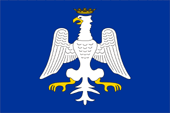 |
1452–1796, Staatsflagge – state flag, Quelle/Source: nach/by: World Statesmen |
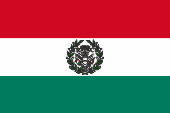 |
1796–1797, Flagge Cispadanische Republik – flag of the Cispadane Republic, Quelle/Source: nach bei: Flags of the World |
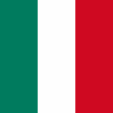 |
1797–1802, Flagge Cisalpinische Republik – flag of the Cisalpine Republic, Quelle/Source: nach bei: Flags of the World |
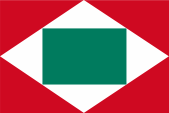 |
1802–1805, Nationalflagge Italienische Republik – national flag of the Italian Republic, Quelle/Source: nach bei: Flags of the World |
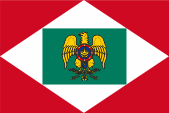 |
1805–1814, Nationalflagge Königreich Italien – national flag of the Kingdom of Italy, Quelle/Source: Von Sodacan Diese Vektorgrafik wurde mit Inkscape erstellt. - Eigenes Werk, CC BY-SA 3.0, Link |
 |
1814–1830, Staatsflagge – state flag, Quelle/Source: nach/by: Flags of the World |
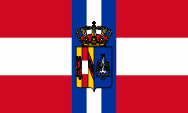 |
1830–1859, Staatsflagge – state flag, Quelle/Source: nach/by: Flags of the World |
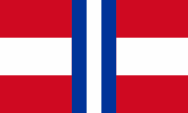 |
1830–1859, Handelsflagge – merchant flag, Quelle/Source: nach/by: Wikipedia (EN) |
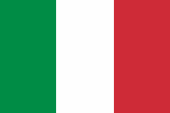 |
1848, Staatsflagge – state flag, Quelle/Source: nach/by: World Statesmen |
|
|
|
Bedeutung/Ursprung der Flagge – Meaning/Origin of the Flag: |
|
| Das Flagge des Herzogtums Modena zeigte ursprünglich das Bild des Wappens der Familie Este, einen bekrönten silbernen Adler auf Blau. Nach dem im Jahre 1796 die Truppen Napoléons in Norditalien einmarschierten, wurde das Herzogtum aufgelöst und es wurde Teil der neugebildeten Cispadanischen Republik (von Napoléons Gnaden). Sie umfasste Modena, Reggio, Bologna und Ferrara. Ihre Flagge zeigte drei waagerechte Streifen in Rot, Weiß und Grün. Im Jahre 1797 vereinigte sich die Cispadanische Republik mit der Transpadanischen Republik (Lombardei, Mantua und Westliches Venetien) zur Cisalpinischen Republik. Ihre Flagge war quadratisch und zeigte drei senkrechte Streifen in Grün, Weiß und Rot. Im Jahre 1802 wurde Modena Teil der Italienischen Republik, die 1805 in ein Königreich Italien unter König Napoléon I. umgewandelt wurde. Die Flagge dieses Landes zeigte ein weißes und ein grünes Rechteck übereinander und eingedreht auf einer roten Flagge. Im Jahre 1814 (Wiener Kongress) wurde das Herzogtum Modena, unter der Herzog Franz IV. von Österreich aus dem Hause Habsburg wiederhergestellt, jedoch wurde die alte Flagge der Familie Este zunächst beibehalten. Im Jahre 1830 führte der Herzog eine neue Flagge ein, die bis zum Ende des Herzogtums im Jahre 1859 beibehalten wurde. Sie kombinierte waagerecht die Hausfarben der Östereichischen Habsburger, die den rot-weiß-roten Bindenschild der Babenberger verwendeten, senkrecht mit den traditionellen Farben von Modena Weiß und Blau. | The flag
of the Duchy of Modena showed originally the image of the coat of arms of
the Este family, a crowned silvery eagle on blue. After Napoleon's troops invaded northern Italy in 1796, the Duchy was abolished and it became part of the newly formed Cispadane Republic (of Napoleon's grace). It included Modena, Reggio, Bologna and Ferrara. Its flag showed three horizontal stripes in red, white and green. In 1797, the Cispadane Republic became united with the Transpadane Republic (Lombardy, Mantua and Western Veneto) to the Cisalpine Republic. Its flag was square and showed three vertical stripes in green, white and red. In 1802 Modena became part of the Italian Republic, which was converted in 1805 into the Kingdom of Italy under Napoleon I. as the king. The flag of this country showed one above the other, a white and a green rectangle, which ist screwed on a red flag. In 1814 (Congress of
Vienna), the Duchy of Modena became restored under the Duke Franz IV. of
Austria from the Habsburg dynasty, however, the old flag of the Este family
was maintained. In 1830 the Duke introduced a new flag, which was used until
the end of the duchy in 1859. The flag combined horizontally the house
colors of the Austrian Habsburgs, who used the red-white- red shield of
Babenberg, and perpendicular with the traditional colors of Modena, white
and blue. |
| Von 1848 bis 1849 wütete in fast ganz Italien der Aufstand der Volksbewegung "Giòvane Itàlia" unter Mazzini und Garibaldi, die Monarchien waren oft kurz entmachtet. In dieser Aufstandsphase wurden in den italienischen Staaten auch national-italienische Flaggen in Grün, Weiß und Rot verwendet. Die nationale italienische Erhebung endete jedoch in Uneinigkeit. | From 1848
to 1849 raged in almost all of Italy the uprising of the people's movement
"Giòvane Itàlia" under Mazzini and Garibaldi, the monarchies were often
shortly disempowered. In this phase of rebellion in the Italian States were often used national-italian flags in green, white and red. However, the Italian uprising ended in disagreement. |
| Quelle/Source: Wikipedia (D), World Statesmen, Volker Preuß | |
Wappen – Coat of Arms: |
|
 |
1830–1859, Wappen Herzogtum Modena – coat of arms Duchy of Modena, Quelle/Source: nach/by: Wikipedia (D) |
Bedeutung/Ursprung des Wappens – Meaning/Origin of the Coat of Arms: |
|
| Das Wappen des Herzogtums Modena ist ursprünglich das Wappen der Familie Este. Es zeigte einen bekrönten silbernen Adler auf Blau. Dieses heraldische Bild taucht dann wieder in der Heraldik der Wappen der Herzöge von Modena aus dem Hause Habsburg wieder auf, denn sie erbten das Land im Jahre 1806. So wird seit 1830 die Heraldik der Österreichischen Habsburger mit der Heraldik der Familie Este in einem gespaltenen Schild kombiniert. | The coat
of arms of the Duchy of Modena was originally the coat of arms of the Este
family. It showed a crowned silvery eagle on blue. This heraldic image then
appears again in the heraldry of the coat of arms of the Dukes of Modena
from the House of Habsburg, because they hertied the land in the year 1806.
Thus, the heraldry of the Austrian Habsburgs is combined with the heraldry
of the Este family in a divided shield since 1830. |
| Quelle/Source: Wikipedia (D), Volker Preuß | |
| Historische Staaten in Italien – Historical states in
Italy: ca. 1850–1858 alle Staatsbezeichnungen in Englisch – all state denominations in English |
|
| Landkarte/Map: Volker Preuß |
Zahlen und Fakten – Numbers and Facts: |
|
|
|
|
|
|
|
|
|
|
|
| Quelle/Source: Meyers Konversationslexikon | |
Geschichte: |
|
Antike
· in der Region siedeln Räter, Umbrer und Kelten ab 5. Jhd. v.Chr. · Einwanderung von Etruskern aus den Alpen ab 225 v.Chr. · römische Eroberung, Errichtung der Provinz Gallia cisalpina 89 v.Chr. · die Provinz Gallia cisalpina wird der Provinz Italien angegliedert 452 · Hunneneinfälle 476 · Absetzung des letzten römischen Kaisers Romulus Augustulus, Ende des (West)Römischen Reiches, die heutige Lombardei gehört bis 493 zum Reich des Odoaker 489 · Eroberung des Gebiets durch die Ostgoten 535 · Eroberung durch Byzanz (Ostrom) 568/569 · Eroberung und Besiedlung durch die Langobarden (zur Lombardei) 774 · Eroberung durch die Franken 781 · Eingliederung der Lombardei in das Frankenreich der Karolinger ca. 800 · Einwanderung der Vorfahren der Familie d'Este 843 · bei der Teilung des Frankenreiches kommt die Lombardei zum Königreich Italien 888 · Nach dem Aussterben der Karolinger zerfällt die Region in Kleinstaaten 961 · Otto I. bringt Modena an das Deutsche Königreich ca. 1000 · Modena tritt dem Lombardischen Bund gegen den deutschen Kaiser bei (Mailand, Bergamo, Lecco, Cremona, Mantua und Brescia) 1056 · Alberto Azzo II., erbaut in der Nähe der Stadt Este die gleichnamige Burg und nennt sich nach ihr, Alberto Azzo d'Este 1167 · der Lombardische Bund stellt sich gegen sich gegen den deutschen Kaiser Friedrich I. (Barbarossa) 1183 · Anerkennung der Unabhängigkeit des Lombardischen Bundes ca. 1215–1350 · Kämpfe zwischen Ghibellinen (Kaiserpartei) und Guelfen (Papstpartei) 1289 · Gründung der Grafschaft Modena, das Lehen erhält die Familie d'Este 1336 · Erwerb von Reggio 1452 · der Deutsche Kaiser Friedrich III. ernennt Borso d’Este zum Herzog von Modena und Reggio 1471 · die Familie d’Este erhält vom Papst die Stadt Ferrara zum Lehen 1597 · Aussterben der Familie d’Este, Cesare d’Este, ein illegitimer Nachkomme der Familie übernimmt Modena und Reggio, Ferrara fällt zurück an den Papst 1633 · Cesare d’Este Alfonso III. erhält von Kaiser Ferdinand die Stadt Correggio zum Lehen 1702 · Spanischer Erbfolgekrieg, Herzog Rinaldo d’Este wird von spanischen und französischen Truppen vertrieben 1703–1706 · Besetzung durch französische Truppen 1707 · Rückkehr von Herzog Rinaldo 1711 · Erwerb des Herzogtums Mirandola 1734–1736 · Besetzung durch französische Truppen 1737 · Erwerb des Herzogtums Novellara 1796 · das Herzogtum Modena wird von französischen Revolutionstruppen besetzt, Herzog Herkules III. Rinaldo wird abgesetzt, Modena wird der Cispadanischen Republik angeschlossen 1797 · Vereinigung der Cispadanischen Republik mit der Transpadanischen Republik (Lombardei, Mantua und Westliches Venetien) zur Cisalpinischen Republik 1801 · Friede von Lunéville, Friedensvertrag zwischen Frankreich und dem Heiligen Römischen Reich Deutscher Nation, das linke Rheinufer kommt an Frankreich, Herzog Herkules III. Rinaldo erhält als Entschädigung für den Verlust seines Herzogtums den Breisgau, den er seinem Schwiegersohn dem Erzherzog Ferdinand von Österreich überträgt 1802 · Modena wird Teil der Italienischen Republik (1805-1814 Königreich unter Napoléon I.) 1805 · Modena wird Teil des Königreichs Italien unter König Napoléon I. 1806 · Friede von Preßburg, Friedensvertrag zwischen Frankreich und Österreich, Ferdinand von Österreich verliert den Breisgau und stirbt, de Jure geht das Erbe an das Haus Habsburg 1814 · Wiener Kongress, Wiederherstellung des Herzogtums Modena, unter Franz IV., der Sohn von Ferdinand von Österreich, als Habsburgische Nebenlinie Österreich-Este, einschließlich der Herzogtümer Massa und Carrara 1831 · Julirevolution in Frankreich, daraufhin Revolte in Modena, der Herzog muss fliehen, kehrt aber im gleichen Jahr mit Österreichischen Truppen zurück 1847 · Erwerb von Fivizzano 1848 · Erwerb von Guastalla 1848 · in fast ganz Italien Aufstand der Volksbewegung "Giòvane Itàlia" unter Mazzini und Garibaldi, Karl Albert von Sardinien-Piemont stellt sich an die Spitze der Erhebung, Unruhen in Modena, Herzog Franz V. flieht, kehrt jedoch mit Hilfe Österreichischer Truppen zurück an die Macht, die italienische Erhebung endet in Uneinigkeit 1859 · italienischer Unabhängigkeitskrieg gegen Österreich, Herzog Franz V. stellt sich an die Seite Österreichs, Unruhen in Modena, Bildung einer provisorischen Regierung und einer Landesversammlung, der Herzog wird abgesetzt und flieht nach Österreich 1860 · Anschluss des Landes an Sardinien-Piemont 1875 · Tod von Herzog Franz V. 17.03.1861 · Krönung von Viktor Emanuel II. von Sardinien-Piemont zum König des Königreichs Italien 1947 · Gründung der Region Emìlia-Romagna als italienische Verwaltungseinheit, sie umfasst die Gebiete der ehemaligen Staaten Herzogtum Parma, Herzogtum Modena und des Kirchenstaates (Patrimonium Petri) |
History: |
|
antiquity
· in the region settle Raetians, Umbrians and Celts since 5th cent. B.C. · immigration of Etruscians from the Alpes since 225 B.C. · Roman conquest, establishment of the Province of Gallia Cisalpina 89 B.C. · the Province of Gallia Cisalpina gets incorporated into the Province of Italy 452 · Hun's invasions 476 · dismissal of the last Roman emperor Romulus Augustulus, end of the (West)Roman Empire, the today's Lombardy belongs until 493 to the Empire of the Odoaker 489 · conquest of the region by the Eastern Goth 535 · conquest by Byzantium (East Rome) 568/569 · conquest and settlement by the Langobardes (to the Lombardy) 774 · conquest by the Franks 781 · incorporation of the Lombardy into the Frankish Empire of the Carolingians ca. 800 · immigration of the ancestors of the d'Este family 843 · at the division of the Frankish Empire comes the Lombardy to the Kingdom of Italy 888 · after the vanish of the Carolingians disintegrates the Region into small states 961 · Otto I. brings Modena to the German Kingdom ca. 1000 · Modena joines the Lombardian Alliance against the German Emperor (Milan, Bergamo, Lecco, Cremona, Mantua and Brescia) 1056 · Alberto Azzo II., builts near the town of Este a castle of the same, and calles himself after it, Alberto Azzo d'Este 1167 · the Lombardian Alliance takes position against the German Emperor Frederick I. (Barbarossa) 1183 · recognition of the independence of the Lombardian Alliance ca. 1215–1350 · fights between Ghibellines (emperor's party) and the Guelfes (pope's party) 1289 · establish of the County of Modena, the feud gets the family d'Este 1336 · acquisition of Reggio 1452 · the German Emperor Frederick III., elevates Borso d'Este to the Duke of Modena and Reggio 1471 · the family d'Este gets the city of Ferrara as a fiefdom by the Pope 1597 · extinction of the d'Este family, Cesare d'Este - an illegitimate descendant of the family - takes Modena and Reggio, Ferrara comes back to the Pope 1633 · Cesare d'Este Alfonso III. receives from Emperor Ferdinand the city of Correggio as a fiefdom 1702 · Spanish War of Succession, Duke Rinaldo d'Este is exiled by Spanish and French troops 1703–1706 · occupation by French troops 1707 · return of Duke Rinaldo 1711 · acquisition of the Duchy of Mirandola 1734–1736 · occupation by French troops 1737 · acquisition of the Duchy of Novellara 1796 · the Duchy of Modena is occupied by French revolutionary troops, Duke Hercules III. Rinaldo is dismissed, Modena becomes annexed to the Cispadan Republic 1797 · merge of the Cispadan Republic with the Transpadane Republic (Lombardy, Mantua and Western Veneto) to the Cisalpine Republic 1801 · Peace of Luneville, peace treaty between France and the Holy Roman Empire of the German Nation, the left bank of the river Rhine comes to France, Duke Hercules III . Rinaldo receives - as compensation for the loss of his duchy - the Breisgau, and transfers it to his son-in-law the Archduke Ferdinand of Austria 1802 · Modena is part of the Italian Republic (1805-1814 Kingdom under Napoléon I.) 1805 · Modena is part of the Kingdom of Italy under King Napoleon I. 1806 · Peace of Pressburg, peace treaty between France and Austria, Ferdinand of Austria loses the Breisgau and dies, de jure the inheritance comes to the House of Habsburg 1814 · Congress of Vienna, restoring of the Duchy of Modena under Franz IV., the son of Ferdinand of Austria, as House of Austria-Este a sideline of Habsburg, including the Duchies of Massa and Carrara 1831 · July Revolution in France, then revolt in Modena, the Duke is forced to flee, but returns in the same year with Austrian troops 1847 · Acquisition of Fivizzano 1848 · Acquisition of Guastalla 1848 · in almost all of Italy uprising of the people's movement "Giovine Italia" under Mazzini and Garibaldi, Charles Albert of Sardinia-Piedmont sets himself at the top of the uprising, riots in Modena, Duke Franz V. flees, but returns with Austrian troops back to power, the Italian uprising ends in disagreement 1859 · Italian war of independence against Austria, Duke Franz V. turns to the side of Austria, roits in Modena, formation of a provisional government and a national assembly, the Duke becomes deposed and flees to Austria 1860 · annexation of Modena to Sardinia-Piedmont 17th of March in 1861 · coronation of Victor Emmanuel II. of Sardinia-Piedmont to the King of the Kingdom of Italy 1875 · death of Duke Franz V. 1947 · establish of the Emilia-Romagna region as an administrative unit of Italy, it includes the territories of the former states of the Duchy of Parma, the Duchy of Modena and of the the Papal States (Patrimony of Peter) |
| Quelle/Source: Wikipedia (D), Atlas zur Geschichte, World Statesmen |
Ursprung des Landesnamens – Origin of the Country's Name: |
|
| Die Stadt Modena wurde von den Etruskern als "Mutina" gegründet. Die Bedeutung des Namens "Mutina" ist unklar. | The city of Modena was founded by the Etruscans as "Mutina". The meaning of the name "Mutina" is unclear. |
| Quelle/Source: Handbuch der geographischen Namen | |
| heutige Regionen Italiens – today's regions of Italy: alle Bezeichnungen in Italienisch – all denominations in Italian |
|
| Landkarte/Map: Volker Preuß |